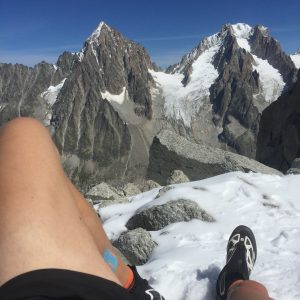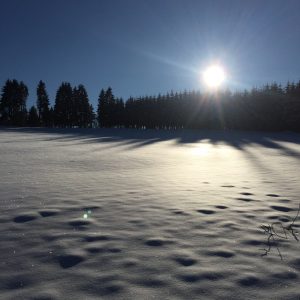Winter is gradually setting in. Temperatures are dropping and soon we'll be able to enjoy those beautiful sunny mornings below zero degrees. Even if running in cold weather remains possible most of the time, it's necessary to adapt to it in terms of equipment, food and training to get 100% out of our outings.
Equipment
When we think of running in winter, we immediately think of the warm gear we'll be wearing to keep out the cold. However, this basic principle needs to respect a few rules in order to be optimal.
-
3-coat system
The 3-layer system is well known to hikers and mountaineers, but it also works for us traileurs. It consists of layering (not systematically) three types of textile.
The first, breathable layer will keep your skin dry by wicking away perspiration. This first layer is more about keeping your body dry than providing warmth.
The second, insulating layer will keep your body heat in. It's really this layer that will insulate you from the surrounding cold. Don't forget, however, that most of the time, this layer will be completely ineffective against the wind.
The third, protective layer protects you from external aggressions (wind, rain, snow, etc.). These could actually be obstacles to your insulation. This third layer will generally be a windproof jacket at minimum to a waterproof jacket at maximum.
This three-layer system is a principle that obviously needs to be adapted according to the weather and the type of outing. In early winter, for example, it's perfectly possible to go out with just a first layer. In fact, an increasing number of technologies now make it possible to cope with low temperatures. In particular, the Mizuno Breath Thermo Virtual Body allows you to dispense with a second layer. So be sure to find out about the properties of the technical textiles you intend to buy.
-
Cover feet, hands and head
30% of body heat escapes through the head. So don't forget to cover your head with a cap or buff. Similarly, special attention should be paid to the feet and hands, which are among the body's coldest spots. This means that heat escapes more easily than elsewhere.
See for yourself. In the middle of winter, it's possible to run in a t-shirt with gloves and a hat without feeling cold, whereas omitting the latter, despite lightly covering your torso, will plunge you straight into the biting cold that surrounds you.
-
In moderation
Paradoxically, covering up too much, or covering up inappropriately for the weather, can be detrimental. You'll sweat, and your clothes won't be able to properly evacuate the excess heat. There's nothing worse than wet clothes in bitterly cold weather. Your body will find it even harder to warm up, and you'll increase the risk of hypothermia.
-
Visibility
In winter, many runners have to do some of their training after dark. So don't forget to equip yourself properly to see (I refer you to the Petzl Nao test) but also, and above all, to be seen! Trail runners are often less exposed to traffic when running in the woods than road runners. Nevertheless, given the often secluded and poorly lit environment, it's all the more important to be visible.
Power supply
Nutrition and hydration are two aspects not to be neglected when running in cold weather. The body needs more energy to maintain its internal temperature. So, for the same distance run in summer and winter, we burn more energy in winter. With this in mind, don't forget to take one or two snacks to prepare for any unforeseen events.
In addition to diet, you also need to pay close attention to hydration in winter. Indeed, the cold suppresses the sensation of thirst. You'll need to force yourself to drink so as not to come home dehydrated from your outing. As you know, losing 1% of body weight in water reduces muscular capacity by 10%.
Running in cold weather does, however, offer a significant advantage when it comes to nutrition. You'll be able to concentrate your isotonic drink more easily. Our gastric system is better able to tolerate "heavier" drinks when it's colder. Take advantage of this, and you'll be able to provide your body with the energy it needs, while staying hydrated at the same time.
Running in cold weather
Ideally, you'll warm up indoors. But most runners (and I'm one of them) tend to shun indoor activities, preferring to throw themselves straight into the enveloping cold of winter. In this case, at the very least, you'll want to fine-tune the lacing, the GPS watch or any other accessory indoors, so as to spend as little time as possible motionless outside.
We'll adapt our outing to the weather. In Belgium and Northern France, this is never a major problem. But in the mountains, you'll need to find out what the weather's like and, if necessary, plan an alternative route. If you're not used to running in cold weather, don't hesitate to plan a looped route so that you can stop your session as quickly as possible if the weather turns nasty.
During your outing, you're bound to sweat. To avoid catching a cold, keep moving. If your outing includes a lot of walking, don't hesitate to take an extra layer to wear during these less intense phases, and stow it in your bag once you're back up to running speed.
In snowy and/or icy conditions, in addition to shoes with a good grip, a suitable stride is recommended. By shortening your stride and increasing your grip, you'll optimize your grip on slippery terrain. By modifying these parameters, your contact time with the ground will be multiplied, giving you a better grip. Runners with a natural stride won't need to adapt. This is based, by nature, on a moderate stride amplitude and high cadence.
Finally, winter is also a season synonymous with colds. Regular running has been shown to reduce the risk of colds. However, if you are unfortunately hit by one of these nasty colds during the winter, it's best to stop all activity if you have flu-like symptoms. On the other hand, as soon as the signs of a cold subside, you can resume running without any problem or risk of relapse. However, it's important to maintain a cool pace (fundamental endurance type).








Hello 🙂
In any weather I got used to the cap, end rather the Pen (of the Triathlete) practical when it's hot we can cool with water and when it rains it protects us from the rain! Otherwise, a buff is still a good thing!
In terms of bottoms, last year I wore thermal pants and shorts over them... This year, for the moment, I'm wearing shorts with kalenji compression undershorts plus compression stockings, and they fit like a glove in this weather!
As a runner rather than a trailer, I usually opt for the kalenji by night lamp, which has a long battery life and good visibility, making it the best value for money. To be honest, I tested the nao during a duathlon in Burdinne and was really taken with it, but it's a running/trail-oriented product.